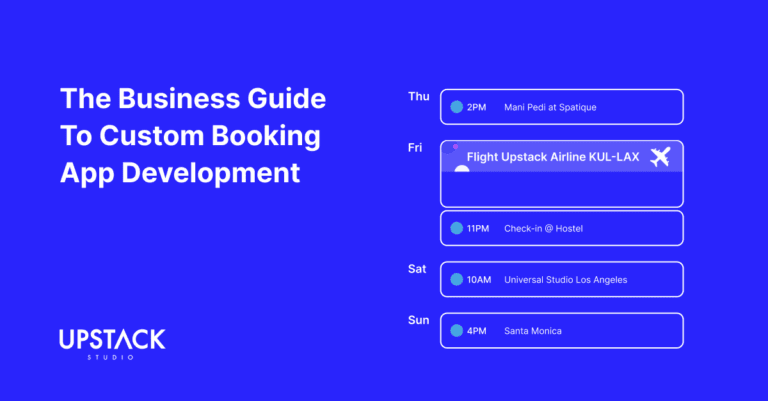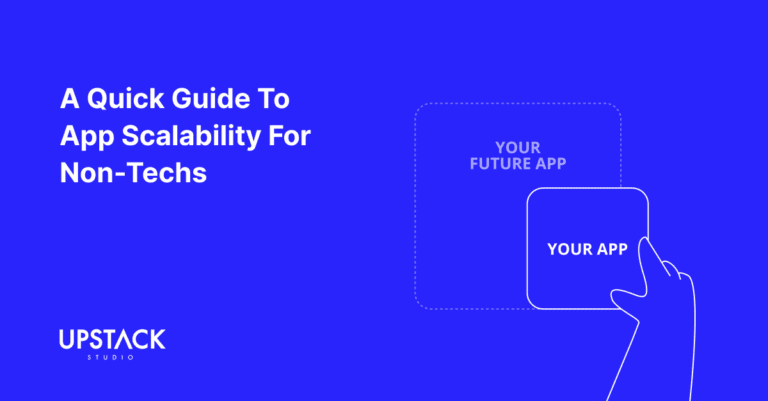In 2022, the worldwide online food delivery market reached a value of $221.65 billion. Experts predict it will grow at an average rate of 10.3% annually from 2023 to 2030.

With such a lucrative market, it’s no surprise there are key players in every area:
- North America: Uber Eats, DoorDash
- Europe: Deliveroo (UK), Just Eat (UK)
- Asia: GrabFood (Southeast Asia), Zomato (India)
- South America: iFood (Brazil), Rappi (Colombia)
- Africa: Jumia Food (Various countries), Mr D Food (South Africa)
Despite how competitive the market is, there’s always room for more.
If you’re considering building your own food delivery app, here’s a step-by-step guide to navigate the journey from concept to execution.
Understanding the Food Delivery Market
Before starting app development, understand the dynamics of the food delivery market and its stakeholders.

Yes, you should analyze consumer behavior, but don’t forget the vendors, delivery riders or drivers, and competitors.
Ultimately, identify emerging trends and carve out your niche.
Planning Your Food Delivery App
Because of how competitive the market is, you can’t really afford to create an app for ‘everyone’.
Instead, you’ll need to narrow your focus to a distinct but sizeable market.
1. Identifying Target Audience
Whether it’s busy professionals craving quick meals or health-conscious individuals seeking nutritious options, understanding your audience is key to success.
Define your target demographic and tailor your app’s features to meet their needs.
2. Define Key Features and Functionality
User-friendly interfaces, real-time order tracking, secure payment gateways, and customizable menus are expected.
What else? Why would your target audience choose you over bigger competitors?
Unless you can answer that, you would be ill-advised to continue with development.
Technology Stack for Food Delivery App Development
Compare development frameworks and languages based on factors like scalability, performance, and developer expertise to find the right technology stack for your food delivery app.
Here’s an example of the technology stack that UberEats uses:
| Category | Technologies Used |
| Frontend | React.js, Redux, GraphQL, Webpack, Jest and Enzyme, Styled-components |
| Backend | Node.js, Python, Go, PostgreSQL, Redis, Apache Cassandra |
| Infrastructure | Kafka, Hive, HDFS, Elasticsearch, MapReduce, File storage |
Frontend Technologies:
- React.js: Core frontend development library for creating reusable UI components and rendering dynamic content efficiently.
- Redux: State management tool for maintaining consistent application state, aiding in debugging, testing, and collaboration.
- GraphQL: Query language for APIs, enabling efficient data fetching from the backend by requesting only the required data.
- Webpack: Module bundler for bundling and optimizing assets like JavaScript, CSS, and images, improving performance.
- Jest and Enzyme: Testing frameworks for writing and running tests for frontend components, ensuring reliability.
- Styled-components: CSS-in-JS library for styling the user interface dynamically, improving performance and maintainability.
Backend Technologies:
- Node.js: Server-side runtime environment known for handling concurrent connections and non-blocking I/O efficiently.
- Python: Used for data processing and analytics due to its versatility and extensive library support.
- Go: Programming language for building high-performance, concurrent systems, ideal for scalable backend services.
- PostgreSQL: Open-source relational database management system for storing and managing structured data with robustness and extensibility.
- Redis: In-memory data store for caching frequently accessed data, reducing latency and improving backend service performance.
- Apache Cassandra: Highly scalable NoSQL database for managing large volumes of data with horizontal scaling and high availability.
Infrastructure Technologies:
- Kafka: Distributed streaming platform for real-time data processing and communication between services.
- Hive: Data warehousing infrastructure for processing and analyzing large datasets.
- HDFS (Hadoop Distributed File System): Distributed file system for storing and managing big data.
- Elasticsearch: Search and analytics engine for indexing and searching large volumes of data.
- MapReduce: Distributed data processing model for processing and generating large datasets in parallel.
- File Storage: Storage solution for managing files and data within the Uber Eats infrastructure.
Your own food delivery app doesn’t immediately have to start with a tech stack this big, but this should give you an idea of how much work goes into a full blown app.
Leveraging Third-Party Services and APIs
Initially, you could approximate a tech stack like UberEats by combining third-party services. It’s known as a piecemeal MVP and is a perfectly valid way to build an app.
This gives you all necessary functions without significantly raising development time and costs, including:
- Location-based services
- Payment gateways
- Push notifications, and
- App analytics
As your app’s user base and revenue grow and it makes sense to move away from third-party services, you can start developing solutions tailored to your specific needs.
Step-By-Step Guide to Developing a Food Delivery App
It really doesn’t matter what app you want to build – the general process looks the same.

In total, there are six steps to app development:
- Selecting an idea
- Validating for market need
- Sketching out Features/Requirements
- Deciding to go No-code/Developer/Co-founder
- Testing & launching
- Gathering feedback & iterating based on user need
1. Selecting an Idea
Before diving into the development process, it’s crucial to select a viable idea for your food delivery app, considering factors such as:
- market demand
- target audience, and
- unique value propositions
Conduct thorough market research to identify pain points and gaps in existing solutions, allowing you to conceptualize an idea that addresses real user needs.
2. Validating for Market Need
Once you’ve narrowed down your idea, validate its potential by assessing market demand and customer preferences.
Utilize surveys, interviews, and market analysis to gather feedback from your target audience and validate assumptions about user behavior, preferences, and willingness to use your app.
This ensures that you’re building a product that meets actual market needs.
3. Sketching out Features/Requirements
Sketch out the features and requirements of your food delivery app.
Define the core functionalities such as user registration, restaurant selection, order placement, payment processing, and order tracking.
Prioritize features based on their importance to users and feasibility for development, and move from sketches to wireframes and ultimately mockups to visualize the user interface and user flow.
4. Deciding to Go No-Code/Developer/ Technical Co-founder
Consider your resources, skills, and goals when deciding how to proceed with app development.
Evaluate whether to build the app yourself using no-code app builders, hire developers to build it for you, or find a technical co-founder to collaborate on development.
Each approach has its pros and cons so choose what aligns best with your objectives.
5. App Testing & Launching
Once development is underway, thoroughly test the app to ensure functionality, usability, and reliability.
Conduct alpha and beta testing with a select group of users to gather feedback and identify any issues or bugs. Iterate on the app based on user feedback and conduct thorough quality assurance to ensure a smooth and seamless experience.
Once testing is complete, launch the app on app stores or other distribution channels, accompanied by a comprehensive marketing strategy to attract users.
6. Gathering Feedback & Iterating Based on User Needs
Continuous iteration based on user feedback is essential for enhancing the app’s usability and staying competitive, so after the app is live, continue gathering feedback from users and monitoring app performance metrics.
Analyze user behavior, reviews, and ratings to prioritize areas for improvement based on impact on user experience, then implement changes accordingly.
Food Delivery App Revenue Streams
There are four typical monetization options for food delivery apps.
1. Delivery Charges
Charge customers a fee for delivery services, either as a percentage of the order price or a flat fee based on distance.
It should provide a stable source of income but may require additional revenue sources for sustainability.
2. Peak Hour Surcharges
Implement surge pricing during peak hours to capitalize on increased demand.
While it does offer extra revenue during busy periods, you risk losing price-sensitive customers to competitors.
3. Advertising
Offer advertising opportunities to restaurants for increased visibility within the app.
This could include higher rates for premium advertising space on the app’s homepage, and implementing a bidding system to allow restaurants to bid on competitor brand names.
4. Commission Percentage
Collaborate with restaurants on commission rates based on order size, charging a percentage of each transaction.
Some apps also include other monetization strategies such as weather-based and rush delivery fees for delivery during bad weather or to expedite a delivery.
Developing a Marketing Strategy For Your Food Delivery App
Obviously, building an app is not enough – you need to make sure people know it exists.

Ideally with multiple strategies, which can include the following:
- Targeted Advertising: Utilize social media advertising, influencer partnerships, and targeted campaigns to reach your audience effectively.
- Promotions and Discounts: Offer enticing promotions, discounts, and referral bonuses to attract new users and retain existing ones.
- Partnerships and Collaborations: Collaborate with restaurants, culinary events, and local businesses to expand your reach and foster community engagement.
Do not underestimate the amount of time and resources marketing an app can consume.
And it’s not really something you can scale down on in the beginning, as you need to get customers on the platform to satisfy the restaurants.
Conclusion
By understanding market dynamics, leveraging technology effectively, and prioritizing user experience, you can carve out your niche in this booming industry.
Ready to embark on your journey to culinary success?
Start building your food delivery app today and grab your slice of the pie – pun intended!
Hey there stranger, thanks for reading all the way to the end. Consider joining our mailing list for a one-stop resource on everything from micro SaaS validation all the way to execution and promotion. Get a nifty list of questions to ask app developers when you sign up!
App Developer Interview Questions Template
Download this template now so you know exactly what to ask App Development Agencies! Let us know where should we send it through the form below.




